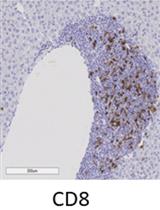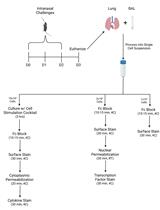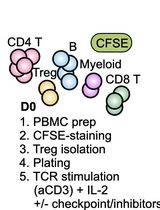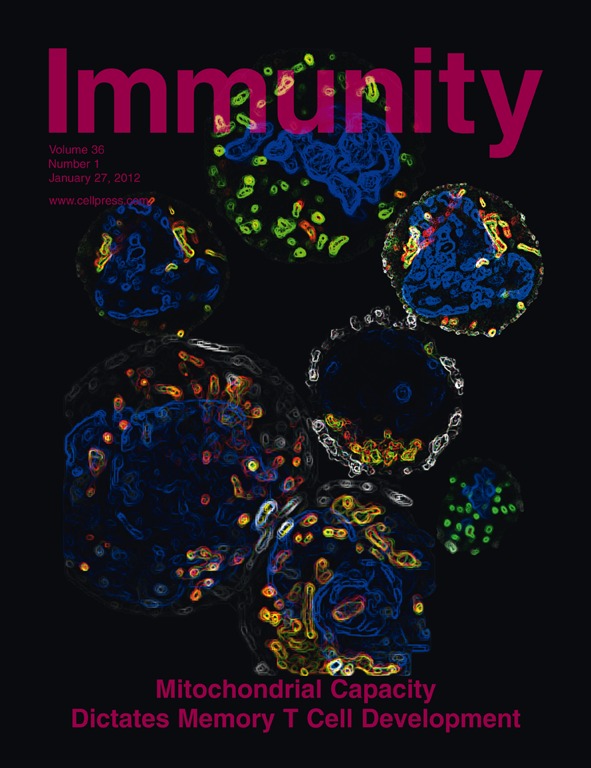- Submit a Protocol
- Receive Our Alerts
- Log in
- /
- Sign up
- My Bio Page
- Edit My Profile
- Change Password
- Log Out
- EN
- EN - English
- CN - 中文
- Protocols
- Articles and Issues
- For Authors
- About
- Become a Reviewer
- EN - English
- CN - 中文
- Home
- Protocols
- Articles and Issues
- For Authors
- About
- Become a Reviewer
Phenotyping of Live Human PBMC using CyTOFTM Mass Cytometry
Published: Vol 5, Iss 2, Jan 20, 2015 DOI: 10.21769/BioProtoc.1382 Views: 20140
Reviewed by: Anonymous reviewer(s)

Protocol Collections
Comprehensive collections of detailed, peer-reviewed protocols focusing on specific topics
Related protocols

Immunohistochemistry of Immune Cells and Cells Bound to in vivo Administered Antibodies in Liver, Lung, Pancreas, and Colon of B6/lpr Mice
Kieran Adam and Adam Mor
Jul 20, 2022 3460 Views

Monitoring Group 2 Innate Lymphoid Cell Biology in Models of Lung Inflammation
Jana H. Badrani [...] Taylor A. Doherty
Jul 20, 2023 2547 Views

Assessing Human Treg Suppression at Single-Cell Resolution Using Mass Cytometry
Jonas Nørskov Søndergaard [...] James B. Wing
Aug 20, 2025 2651 Views
Abstract
Single-cell analysis has become an method of importance in immunology. Fluorescence flow cytometry has been a major player. However, due to issues such as autofluorescence and emission spillover between different fluorophores, alternative techniques are being developed. In recent years, mass cytometry has emerged, wherein antibodies labeled with metal ions are detected by ICP-MS. In order for a cell to be seen, a metal in the mass window must be present; there is no analogous parameter to forward or side scatter. The current mass window selected is approximately AW 103-196, which includes the lanthanides used for most antibody labeling, as well as iridium and rhodium for DNA intercalators.
In this protocol, we use a cocktail of antibodies labeled with MAXPAR metal-chelating polymers to surface-stain live PBMC that have been previously cryopreserved. Many of these markers were taken from a standard fluorescence phenotyping panel (Maecker et al., 2012). No intracellular antibodies are used. We use a CyTOFTM (Cytometry by Time-Of-Flight) mass cytometer to acquire the ICP-MS data. Subsequent analysis of the dual count signal data using FlowJo software allows for cell types to be analyzed based on the dual count signal in each mass channel. The percentage of each cell type is determined and reported as a percent of the parent cell type.
Materials and Reagents
- Peripheral blood mononuclear cells (PBMC) (fresh, or frozen after Ficoll isolation procedure)
- RPMI (HyClone, catalog number: SH30027.01 )
- FBS (heat-inactivated before use) (Atlanta Biologicals, catalog number: S11150 )
- Pen-Strep-Glutamine (100x) (HyClone, catalog number: SV30082.01 )
- Benzonase (25 x 105 U/ml) (Pierce Antibodies, catalog number: 88701 )
- MilliQ water [no contact with beakers or bottles washed with soap (due to barium content of most commercial soaps)]
- PBS (10x stock) (Rockland, catalog number: MB-008 )
- Bovine serum albumin (BSA) (30% w/v in 0.85% NaCl) (Sigma-Aldrich, catalog number: A7284 )
- 0.5 M EDTA (pH 8.0) (Hoefer, catalog number: GR123-100 )
- Sodium azide (10% w/v solution) (Teknova, catalog number: S0209 )
- 2% para-formaldehyde (PFA) (16% w/v aqueous stock, methanol-free, diluted to 2% in 1x CyPBS) (Alfa Aesar, catalog number: 43368 )
- Maleimide-DOTA (Macrocyclics, catalog number: B-272 )
- 139-Lanthanum (chloride salt) (Sigma-Aldrich, catalog number: 203521 )
- 115-Indium (chloride salt) (Sigma-Aldrich, catalog number: 203440 )
- Phenotyping antibodies (filtered with 0.1 μm spin filters) (MIllipore, catalog number: UFC30VV00 )
- Ir-intercalator stock solution from Fluidigm (catalog number: 201192B ; Rh103-intercalator catalog number: 201103B can be used)
- 10x saponin-based permeabilization buffer (eBiosciences, catalog number: 00-8333-56 )
- Complete RPMI (see Recipes)
- CyPBS (see Recipes)
- CyFACS buffer (see Recipes)
- Live-dead stain (see Recipes)
Equipment
- 37 °C water bath
- 96-well plate: 300 μl well volume (250 μl washes) or 1.2 ml well volume (500 μl washes)
Note: If using a 300 μl plate, do an additional wash step (resuspension and centrifugation) at each point. - Biosafety cabinet
- Centrifuge
- Calibrated pipettes
- ViCell (Beckman Coulter) or Hemocytometer cell counter
- CyTOFTM version 1 mass cytometer (Fluidigm Sciences)
Software
- FlowJo software
- Microsoft Excel
Procedure
- Thaw PBMC
- Warm Complete RPMI media to 37 °C in water bath. Each sample will require 20 ml of media with benzonase. Calculate the amount needed to thaw all samples, and prepare a separate aliquot of warm media with 1:10,000 benzonase (25 U/ml final concentration; benzonase removes reduces viscosity and background from free DNA from lysed cells). Thaw no more than 10 samples at a time.
- Remove samples from liquid nitrogen and transport to lab on dry ice.
- Place 10 ml of warmed benzonase media into a 15 ml tube, making a separate tube for each sample.
- Thaw frozen vials in 37 °C water bath.
- When cells are nearly completely thawed, carry to hood.
- Add 1 ml of warm benzonase media from appropriately labeled centrifuge tube slowly to the cells, then transfer the cells to the centrifuge tube. Rinse vial with more media from centrifuge tube to retrieve all cells.
- Continue with the rest of the samples as quickly as possible.
- Centrifuge cells at (RCF = 483) for 10 min at room temperature.
- Remove supernatant from the cells and resuspend the pellet by tapping the tube.
- Gently resuspend the pellet in 1 ml warmed benzonase media. Filter cells through a 70 micron cell strainer if needed (i.e. if you observe any clumps). Add 9 ml warmed benzonase media to the tube to make volume 10 ml altogether.
- Centrifuge cells (RCF = 483) for 10 min at room temperature.
- Remove supernatant from the cells and resuspend the pellet by tapping the tube.
- Resuspend cells in 1 ml CyFACS buffer.
- Count cells with Vicell (or hemocytometer). To count, take 20 μl cells and dilute with 480 μl CyPBS in Vicell counting chamber. Load onto Vicell as PBMC with a 1:25 dilution factor.
- Calculate the resuspension volume needed to obtain 1 million viable cells.
Note: It is typical to recover 4-8 x 106 cells from a vial frozen at 10 x 106 cells/vial.
- Warm Complete RPMI media to 37 °C in water bath. Each sample will require 20 ml of media with benzonase. Calculate the amount needed to thaw all samples, and prepare a separate aliquot of warm media with 1:10,000 benzonase (25 U/ml final concentration; benzonase removes reduces viscosity and background from free DNA from lysed cells). Thaw no more than 10 samples at a time.
- Stain cells
Day one- Add 1 million viable cells from a donor into a well of the 96 well plate. Repeat for all samples. Add CyFACS buffer to approximately 600 μl and centrifuge cells (RCF = 483) for 10 min at room temperature.
- Flick or aspirate to remove supernatant, and repeat wash step and centrifugation with 500 μl CyFACS.
- Make cocktail in CyFACS buffer of metal-chelating polymer-labeled antibodies according to previously determined titration. Make sufficient volume for each sample to have 50 μl of cocktail. Pipet into 0.1 μm spin filter and centrifuge in a tabletop microcentrifuge (RCF = 14,000) for 10 min at room temperature.
- Flick or aspirate to remove supernatant from second wash step B2. Add 50 μl antibody cocktail to each sample. Pipet up and down to mix. Incubate on ice for 60 min.
- Add 500 μl CyFACS buffer, then centrifuge cells (RCF = 483) for 10 min at room temperature. Flick or aspirate to remove supernatant, resuspend pellet in 500 μl CyFACS, and centrifuge cells (RCF = 483) for 10 min at room temperature.
- Make 1:3,000 dilution in CyPBS of 5 mg/ml live-dead maleimide-DOTA stain. Add 100 μl to each sample, pipetting to mix. Incubate on ice for 30 min.
- Add 500 μl CyFACS buffer, then centrifuge cells (RCF = 483) for 10 min at room temperature. Flick or aspirate to remove supernatant, resuspend pellet in 500 μl CyFACS, and centrifuge cells (RCF = 483) for 10 min at room temperature.
- Add 100 μl of 2% PFA (in CyPBS); pipet to mix. Place at 4 °C overnight. PFA fixation is required due to permeabilization and MilliQ water wash osmotic stress in Day two.
- Add 500 μl CyFACS buffer, then centrifuge cells (RCF = 805) for 10 min at 4 °C. Flick or aspirate to remove supernatant, resuspend pellet in 500 μl CyFACS, and centrifuge cells (RCF = 805) for 10 min at 4 °C.
Note: It is common to increase RCF after fixation, particularly during permabilization steps. Live cells in Day 1 cannot take the stress. - Make 1x saponin permeabilization buffer in CyPBS. Flick or aspirate to remove supernatant from step 9. Add 100 μl of 1x saponin permeabilization buffer to each sample, pipet to mix. Incubate on ice for 45 min.
- Add 500 μl CyFACS buffer, then centrifuge cells (RCF = 805) for 10 min at room temperature. Flick or aspirate to remove supernatant, resuspend pellet in 500 μl CyFACS, and centrifuge cells (RCF = 805) for 10 min at 4 °C.
- Make 1:2,000 dilution in CyPBS of Ir-intercalator. Add 100 μl of diluted Ir-intercalator solution to each sample, pipet to mix. Incubate at room temperature for 20 min.
- Add 500 μl CyFACS buffer, then centrifuge cells (RCF = 805) for 10 min at room temperature. Flick or aspirate to remove supernatant, resuspend pellet in 500 μl CyFACS, and centrifuge cells (RCF = 805) for 10 min at 4 °C. Flick or aspirate to remove supernatant, and repeat at least twice with 500 μl of MilliQ water. The MilliQ water washes are critical to remove buffer salts, which can cause the Current setting on the CyTOF to drift over the course of your experiment.
- Acquire samples on the CyTOF, after standard instrument setup procedures. Collect at least one “push” of 500 μl per sample.
- Add 1 million viable cells from a donor into a well of the 96 well plate. Repeat for all samples. Add CyFACS buffer to approximately 600 μl and centrifuge cells (RCF = 483) for 10 min at room temperature.
- Analyze data
- Analyze data using FlowJo software using the standard CyTOF template. Adjust gates on a donor-specific basis, if necessary, to control for any differences in background or positive staining intensity. Export the statistics for each gated population to an Excel spreadsheet.
Recipes
- Complete RPMI
Note: Combine and 0.2 μm filter to sterilize before use.
RPMI 500 ml
50 ml heat-inactivated FBS
5 ml Pen-Strep-Glutamine 100x stock - CyPBS
Dilute 10x PBS to 1x with MilliQ water - CyFACS buffer
1x CyPBS with 0.1% BSA
2 mM EDTA and 0.05% Na azide
Made in MilliQ water
Note: Do not use FBS! - Live-dead stain
5 mg/ml maleimide-DOTA loaded with 139-Lanthanum* or 115-Indium*
*Natural-abundance metal chloride salt used; >95% specified isotope; trace-metal pure 99.99%
Dissolve solid DOTA-Maleimide at 41.5 mg/ml in L-buffer (Fluidigm) or MilliQ water acidified with nitric acid (100 u 3% v/v nitric acid per 10 ml water) containing 25 mM Metal (III) salt. Incubate at room temperature for 15 min, then aliquot and freeze at -20 °C.
41.5 mg/ml is 50 mM for the DOTA Maleimide. The 2:1 molar ratio of DOTA: Metal is intended to reduce/eliminate unchelated metal in the barcoding reagent.
Note: Each new batch of metal-loaded maleimide-DOTA should be titered for best resolution of live vs dead cells, with minimal background. Therefore, final working concentration and final dilution may vary slightly from batch to batch.
Acknowledgments
We would like to acknowledge funding from NIH grants S10RR027582, 5U19AI057229, and 5U19AI090019. We would also like to thank Dr. Evan Newell for initial protocol development (Newell et al., 2012).
References
- Maecker, H. T., McCoy, J. P. and Nussenblatt, R. (2012). Standardizing immunophenotyping for the Human Immunology Project. Nat Rev Immunol 12(3): 191-200.
- Newell, E. W., Sigal, N., Bendall, S. C., Nolan, G. P. and Davis, M. M. (2012). Cytometry by time-of-flight shows combinatorial cytokine expression and virus-specific cell niches within a continuum of CD8+ T cell phenotypes. Immunity 36(1): 142-152.
Article Information
Copyright
© 2015 The Authors; exclusive licensee Bio-protocol LLC.
How to cite
Leipold, M. D. and Maecker, H. T. (2015). Phenotyping of Live Human PBMC using CyTOFTM Mass Cytometry. Bio-protocol 5(2): e1382. DOI: 10.21769/BioProtoc.1382.
Category
Immunology > Immune cell staining > Mass cytometry
Immunology > Immune cell staining > Immunodetection
Cell Biology > Single cell analysis > Mass cytometry
Do you have any questions about this protocol?
Post your question to gather feedback from the community. We will also invite the authors of this article to respond.
Tips for asking effective questions
+ Description
Write a detailed description. Include all information that will help others answer your question including experimental processes, conditions, and relevant images.
Share
Bluesky
X
Copy link









